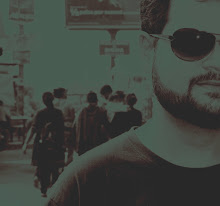Ishaqzaades
of the season. Parma, Zoya, Atindra and Ela. A period film that goes
talk-talk-talkie on discourses and counter-discourses on nationalism and
patriotism with the two lovers in the centre while a Hindi pot-boiler that has
a pair hurling abuses at each other,all for a
political rivalry, till their hearts unite. What remains, is Ma ja
chhilen, tai e achhen. Tagore’s novella is a complex tale of metaphors
regarding nationalism and enmeshed in the narrative is the story of two hearts torn in conflict between the
devotion to the nation, to each other and perhaps to the truth, they keep on
seeking. The Hindi film focuses on a modern day tale of ma, maati, manush where a mother gets
killed, Almore gets a heartless MLA and the common people remain victims to
those in power.
 |
| Kapoor and Chopra |
Hindi films
really have come a long way. There was a time when the actors changed their
clothes thrice for one song sequence. Now, they are seen wearing the same
clothes in different scenes. Realism is at its best! And yes, again a rustic hero
who struggles to graduate and doesn’t feel the need to talk in English. Colonial
hangover is finally coming to an end for the 'man' in Bollywood. The film flies on the wings of these two new faces and every frame
is dedicated to promote the new talents, sometimes sadly at the cost of the screenplay.
A refreshing face is that of Gauhar Khan whose Chand is an amalgamation of mehtaab and aftaab, the
loneliness of the moon and the scorching sun. Her presence, and her curves,
literally make you go “jhalla wallah”
.
Amit
Trivedi’s score compliments the electrifying performances and Hemant Chaturvedi’s
camera does justice in capturing imaginary Alomre. And after a long time, choreographers Rekha and Chinni Prakash make the leading pair as well Gauhar Khan shake their legs (and hips) to the refreshing dance moves. Pareshan has been picturized adroitly and so are Jhalla Wallah and Chokhra jawan re. The film sparkles through
the DOP’s lenses capturing the rusticity and the rich colours symbolizing the vibrance of the two lovers. The supporting
cast has new faces and each character does justice to his/her role. The second
half, almost like every other film, drags and again Aarti Bajaj, the editor,
disappoints. What remains after the two hours of continuous chases and gun
shots is the promise of power-house performances by Parineeti in the near future which will definitely make her audience “pareshan.” As for the story (Aditya Chopra and Habib Faisal), the
first half is a Hate Story recall and
the second, predictable.
If only Zoya
could utter the last words like Ela to her Parma, the ending could have been
dramatic indeed. What was missing in Ishaqzaade’s
last scene was a lip-lock.(Or, may be Zoya would have never liked it; she had once complained about the khula-khula jagah.)“Shesh chumbon
aj afuran holo Antu”; Elar Char
Adhyay is another tale of passion. Ela’s passion for the land and her love.
Bappaditya Bandopadhyay’s film fairly does justice to Tagore’s novella. For a philosophical
text that Char Adhyay is, it is a
mammoth task to adapt it on screen. Beware audience, if you are looking or
sequential plots and dramatic moments, this is definitely not the film. This is
neither Ray’s Charulata nor Ghosh’s Chokher Bali or Noukadubi. Here the characters talk, and talk in a language that
becomes difficult for a large number of audiience to understand. The riddles and
the metaphors, the discourses on patriotism and Ela and Atindra’s nature of
love story do not promise an arresting audience. Kudos to the director for keeping the original dialogues from the text. However, the screenplay falters at times to capture the essence of the text.
Indranath (Indraneil Sengupta) looks rehearsed in delivering his part and so does
debutant Vickram Chatterjee (Atindra). Paoli Dam as Ela is good but she could
have been far better. Her zero-figure is a mismatch for a Bengali Ela. The film
only thrives on its dialogues, the continuous talking that the characters
engage themselves in and this where the film stands apart from the other
Tagorean adaptations. The conflicts and the confrontations become the
protagonists of the film. The characters merely fit into the plethora of discourses
on motherland, patriotism and love.
 |
| Paoli Dam as Ela |
By the way, has anyone done Wuthering Heights in Hindi? Well, a Catherine and a Heathcliff are surely in the making!!
